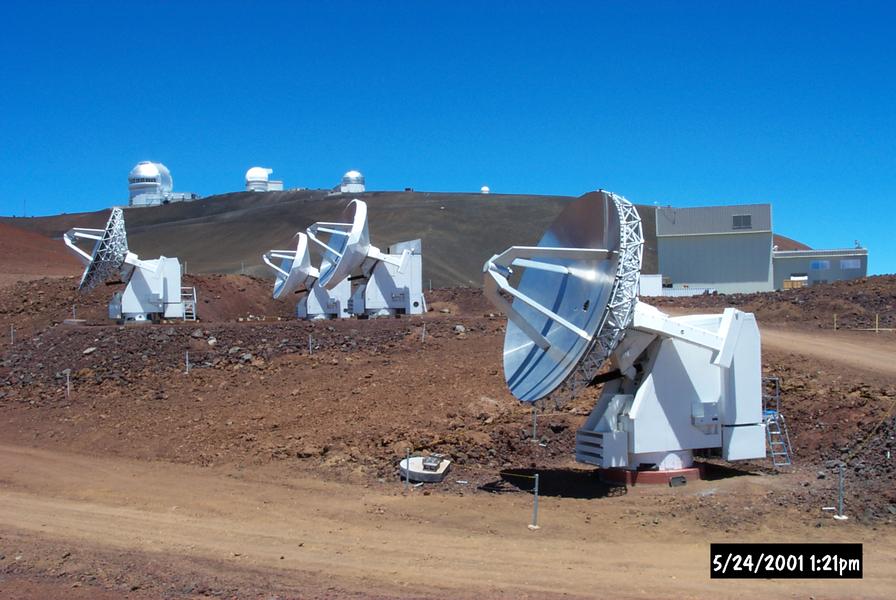
The Smithsonian Astrophysical Observatory and Academica Sinica of Taiwan are currently building the Sub-Millimeter Array on Mauna Kea.
 Copyright © Michael Richmond.
This work is licensed under a Creative Commons License.
Copyright © Michael Richmond.
This work is licensed under a Creative Commons License.
People usually think of the space between stars as being inconceivably empty, a pure and perfect vacuum. While it is true that even the densest regions of interstellar space contain less matter per cubic meter than the best vacuum we can create on Earth, it is a grave mistake to think of the space between stars as empty. Interstellar space is full of material. In our Milky Way galaxy there is more than 10 billion sun's worth of material floating between the stars in what astronomers call the InterStellar Medium (or ISM for short). That is certainly far too much stuff to be called "empty!"
Just counting up kilograms of interstellar medium won't explain why the ISM is so important. The material between the stars plays a pivotal role in what might be called galactic ecology - a vast cosmic cycle in which matter is channeled into stars, processed into heavy elements and blown back into space to form new stars. Every atom in your body was once part of the ISM. In this chapter we will explore the interstellar medium and the beginnings of the cosmic mass cycle: the formation of stars.
You don't have to spend a lot of time looking up before you notice that the clouds in the sky comes in a lot of different varieties. There are high, thin cirrus clouds and low, hanging cumulonimbus clouds. The interstellar medium is not very different. Astronomers studying the matter between the stars have found that it appears in many different varieties. They call these structures "clouds". Unlike the clouds on Earth, however, many of the forms of interstellar clouds are completely invisible to the human eye. A full inventory of interstellar matter could not be completed until astronomers were able to see the sky at all wavelengths in the electromagnetic spectrum. The emergence of radio, infrared, UV and X-ray telescopes (some based on orbiting platforms) has provided essential contributions to astronomer's understanding of the ISM and its role in stellar evolution

The Smithsonian Astrophysical Observatory and Academica Sinica of Taiwan
are currently building the Sub-Millimeter Array on Mauna Kea.
Astronomers studying the ISM have found that about 90% of its atoms are hydrogen. The hydrogen in the ISM can be found in different states: ionized, with electrons and protons wandering independently, atomic, in which each atom holds its single electron tightly, or molecular, in which pairs of hydrogen atoms bond together. Since hydrogen is so common, astronomers have named the different types of ISM clouds after the form of hydrogen they contain. Scientists have found that they can describe the ISM reasonably well using just four basic types of interstellar cloud: diffuse HI (read as "H one") clouds, molecular clouds, the Warm Intercloud Medium (WIM), and hot coronal gas. Table X gives an overview of their properties and, in what follows, we will discuss each in a little more detail
(please turn this into a nice HTML table with subscripts)
Table XX: Structural Components of the ISM
Component Temperature Density State
(K) (atoms/cm^3)
----------------------------------------------------------------------------
HI clouds 50 - 100 1 - 10^3 neutral atoms
Molecular clouds 20 - 50 10^3 - 10^5 molecules
WIM 10^3 - 10^4 0.01 partially ionized
Coronal gas 10^5 - 10^6 10^(-4) - 10^(-3) fully ionized
-----------------------------------------------------------------------------
Scientists use roman numerals to indicate the degree of ionization of elements: a one, "I", means "not ionized at all", a two, "II", means "one electron has been removed," a three, "III", means "two electrons have been removed," and so forth. Portions of the ISM composed mainly of neutral hydrogen are therefore called "HI clouds." These clouds are cold (T = 50 - 100 K), and mildly dense (1 to 1000 atoms/cm^3). Note to editor: that should "cm" with a superscript "3". While they are numerous and can found throughout the disk of the galaxy, individual clouds are relatively small, extending only over a few parsecs.
Detecting HI clouds was not possible until astronomers began using radio telescopes in the mid 1950s. Both the electron and the proton in an H atom have a property that is akin to the spin of a top. Electromagnetic interactions between the two particles can flip the spinning electron causing it to emit or absorb a photon with a wavelength 21 cm (which is in the radio part of the spectrum). These photons have such a long wavelength they can penetrate most intervening material. The prevalence of hydrogen gas along with the penetrating power of the 21-centimeter radiation it emits in neutral form has allowed astronomers to detect HI clouds across great distances and use them to map out the spiral structure of the Milky Way.
Ed. note: please crop (don't shrink) these two pictures to fit the space available. Remove equal amounts from both sides of the image to keep them centered on the center of the Milky Way. Please be sure to cut off the letters at the right edge of the top picture.


Caption: (top) A map of the Milky Way in 21-cm radio waves shows a flat disk of gas and a ring around the center of the galaxy. (bottom) In visible light, our view is blocked by clouds of dust.
Molecular Clouds are the densest regions of interstellar space. Individual clouds may be more than one million times the mass of our sun. These structures play a crucial role in star formation, so we will focus quite a bit on their properties in this chapter.
Molecular clouds are formed primarily of hydrogen arranged in molecules consisting of two atoms: H2. Note to editor: this should be "H with a subscript 2" Unfortunately for astronomers, hydrogen molecules are notoriously secretive. They don't interact with light in the visible part of the spectrum making them invisible to optical telescopes. In fact, under the conditions inside a molecular cloud. they don't emit or absorb much radiation at all, even in other regions of the electromagnetic spectrum.
To observe molecular clouds astronomer must rely on TRACERS, materials which make up only a small portion of a cloud, but which are easy to detect. We use tracers in ordinary life, too. For example, television executives want to know who's watching which television programs. They can't afford to ask directly the hundreds of millions of viewers, so they take an indirect approach: they pick a few thousand individuals and families and study their viewing habits. These households act as "tracers" for the entire population: if 30% of them watch a particular program, odds are that roughly 30% of everyone is watching it.
Astronomers use several kinds of tracers when studying molecular clouds. Dust makes a good tracer: particles embedded in molecular clouds can block light from background stars, revealing the cloud as a silhouette. When warmed by the radiation from nearby young stars, the dust can also glow in the far infrared and millimeter region of the spectrum.
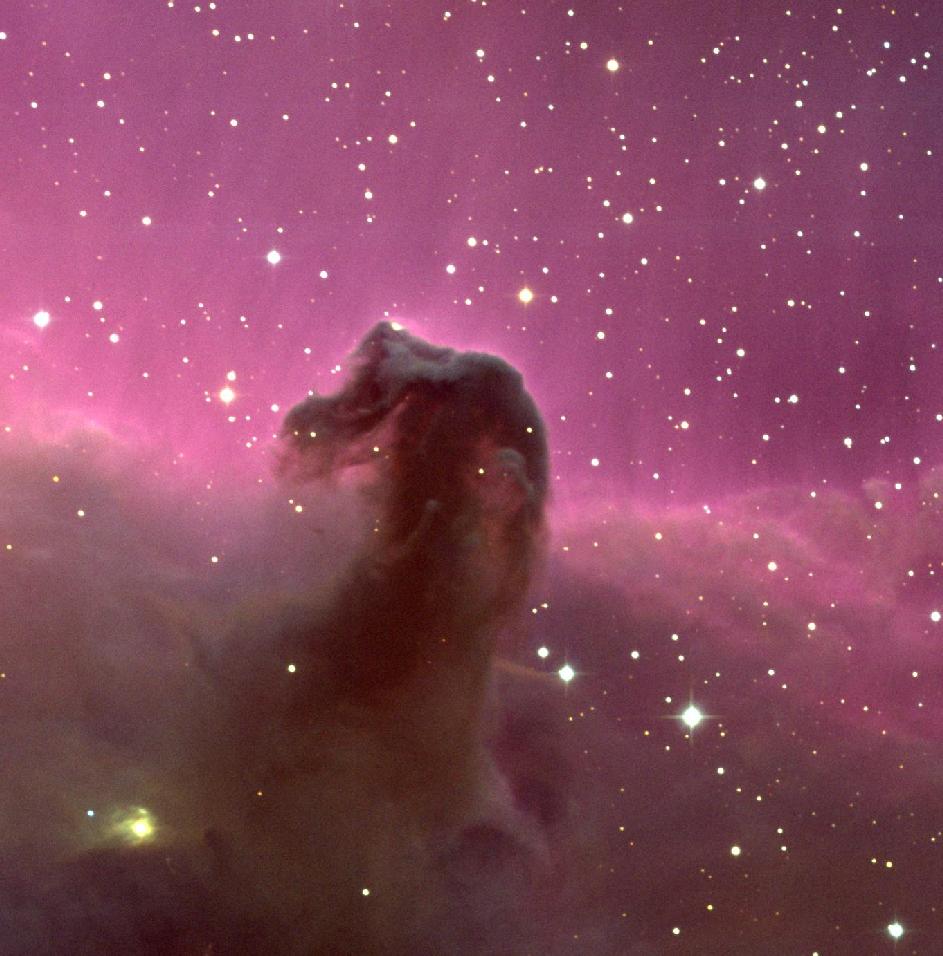
Image courtesy of Nigel Sharp (NOAO), NSF.
Caption: Dust in the Horsehead
Nebula blocks light from stars behind it.
The best tracers for molecular clouds, however, turn out to be an astonishing variety of molecules which live deep within them. Most molecules are quickly broken apart by ultraviolet radiation in space. Dense clouds, however, block ultraviolet photons very effectively. Deep inside the clouds, conditions are so favorable that an astonishing array of organic molecules have been detected. The term "molecular" in molecular cloud is certainly well deserved.
Note to editor: please make table in HTML, with subscripts for the numbers in chemical formulas.
Table XXI: Selected Interstellar Molecules
Chemical Formula Molecule Chemical Formula Molecule
-----------------------------------------------------------------------------
H2 molecular hydrogen | H2S hydrogen sulfide
C2 diatomic carbon | N2O nitrous oxide
CN cyanogen | H2CO formadehyde
CO carbon monoxide | C2H2 acetylene
NO nitric oxide | NH3 ammonia
OH hydroxl | HCO2H formic acid
NaCl sodium chloride | CH4 methane
HCN hydrogen cyanide | CH3OH methyl alcohol
H2O water | CH3CH2OH ethly alcohol
-----------------------------------------------------------------------------
Carbon monoxide (CO) molecules, for example, can exist only deep inside dense clouds of hydrogen, protected by the outer layers of gas and dust. If we detect CO gas, we can conclude that there is also molecular hydrogen surrounding it. Because hydrogen atoms are so much more common than carbon and oxygen atoms, even a little CO implies a great deal of H2: a single CO molecule corresponds to over a million H2 molecules! Carbon monoxide is a handy tracer because, unlike molecular hydrogen, it emits and absorbs electromagnetic radiation efficiently. It is particularly active in the millimeter region of the spectrum. Astronomers are now building a number of arrays of telescopes sensitive to millimeter waves in order to study interstellar CO molecules in great detail -- which will tell us a great deal about the molecular clouds in which they live.
Ed. note: Again, please crop (don't shrink) these pictures to fit the space available. Remove equal amounts from both sides of the image to keep them centered on the center of the Milky Way. Please be sure to cut off the letters at the right edge of the top picture.


Caption: (top) This map of CO in the Milky Way
shows the distribution of molecular clouds.
(bottom) A picture of the Milky Way in visible light.
Both the diffuse HI clouds and the molecular clouds are quite cold, with temperatures below 100 degrees Kelvin. There are, however, vast regions of the intergalactic medium that are quite hot. Between the denser, colder forms of interstellar gas lies the so-called Warm Intercloud Medium (WIM for short). Temperatures in the WIM are typically 10,000 degrees Kelvin, which seems warm indeed. This gas is extremely tenuous: its typical density is only .01 atoms per cubic centimeter. This number may seem strange to you -- how can fractions of a atom exist? What it means is there is only one chance in a hundred of finding a single hydrogen atom in a box one centimeter on a side. The WIM extends across much of the galaxy and, despite its very low density, comprises almost 50% of the mass of the ISM.
not written yet (How is it observed)
The last form of the ISM that we will consider makes the "warm" gas of the WIM seem frigid in comparison. Between the other forms of interstellar matter are pockets of gas at temperatures of over one million degrees. This material is called "coronal gas", after a similarly hot region around the Sun called the solar corona. The coronal regions of the ISM are fantastically empty, with densities of 10^(-4) Ed Note: that's 10 with superscript "-4" atoms per cubic centimeter. It's not surprising to find that this rarefied material makes up than five percent of the ISM by mass. Astronomers believe that the hot coronal gas is material blown out of violent supernova explosions.
At such high temperatures, collisions between atoms in the coronal gas are able to rip electrons from their parent nuclei. Atoms in the coronal gas can be so highly ionized that we sometimes see light from ions like CIV (carbon missing three electrons) or OVI (oxygen missing five electrons).
Ed. note: Again, please crop (don't shrink) these pictures to fit the space available. Remove equal amounts from both sides of the image to keep them centered on the center of the Milky Way. Please be sure to cut off the letters at the right edge of the top picture.


Caption: (top) A map of the Milky Way in X-rays
shows the location of very hot coronal gas.
Note that X-rays are blocked by the same clouds
that block visible light in the picture below.
(bottom) A picture of the Milky Way in visible light.
Ed. Note: here are the four images through which the user should cycle here. The fixed caption appears first. I tried to make all the figures 424 pixels wide.
Caption: Views of the Andromeda Galaxy, M31, at different wavelengths
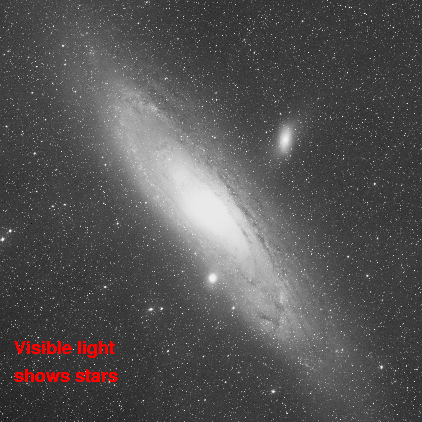
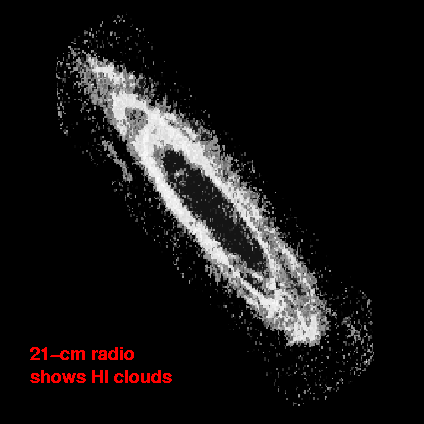
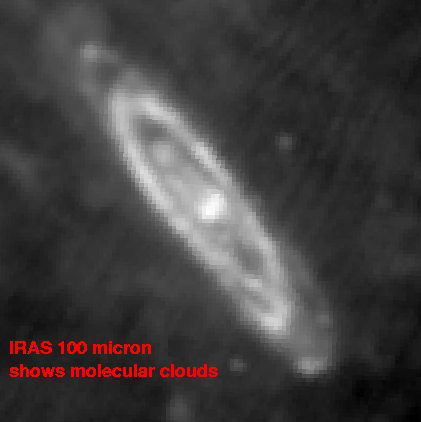
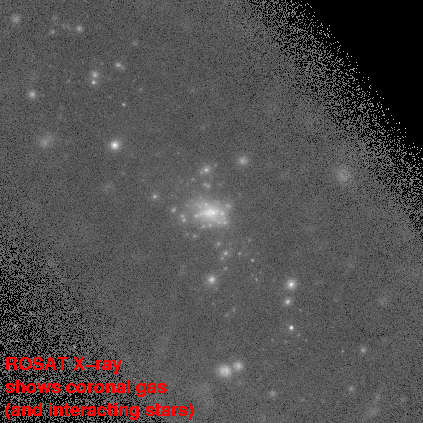
Ed Note: and here is the thumbnail for the text.
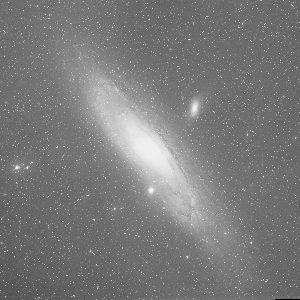
This idea of PRESSURE EQUILIBRIUM can be expressed in a simple equation. If we use the symble Pc P subscript c to describe the pressure within a cloud, and Pb P subscript b the pressure of the "background" (material surrounding the cloud), then the fact that the cloud neither expands nor contracts means
please make this an equation with subscripts
P = P
c b
But what determines the pressure in a cloud, and why should different clouds in the ISM be in pressure balance? Remember that in section X, we discussed the ideal gas law, which describes a relationship between the pressure, density and temperature of a gas. This law can be written
P = k n T
Where P is the pressure of the gas,
n is the number of particles per cubic centimeter,
T is its temperature,
and k is a constant which depends
on the chemical composition.
Since k is very nearly the same for all clouds,
the pressure is basically
a function of the temperature and density.
If a cloud and the surrounding material are in
pressure equilibrium, then
Ed note: I've indicated subscripts in this eqn -- please make them look good in HTML.
n T = n T
c c b b
What does this formula tells us about the ISM?
Notice that there are many ways a cloud can reach
pressure balance with the material around it:
it might have a low density, but high temperature;
or a high density, and low temperature;
or a medium density and medium temperature.
If you look carefully at the values in
Table XX,
you'll see that
multiplying n by T yields nearly the same
result for all phases of the ISM.
Astronomers believe this did not occur by accident but through an evolutionary process: interstellar matter changes its form, expanding or contracting, heating or cooling until it reaches equilibrium with its environment. Although in real life the ISM is more dynamic than this static picture, the approximation does capture the essence of much of what we see in the ISM.
 Copyright © Michael Richmond.
This work is licensed under a Creative Commons License.
Copyright © Michael Richmond.
This work is licensed under a Creative Commons License.